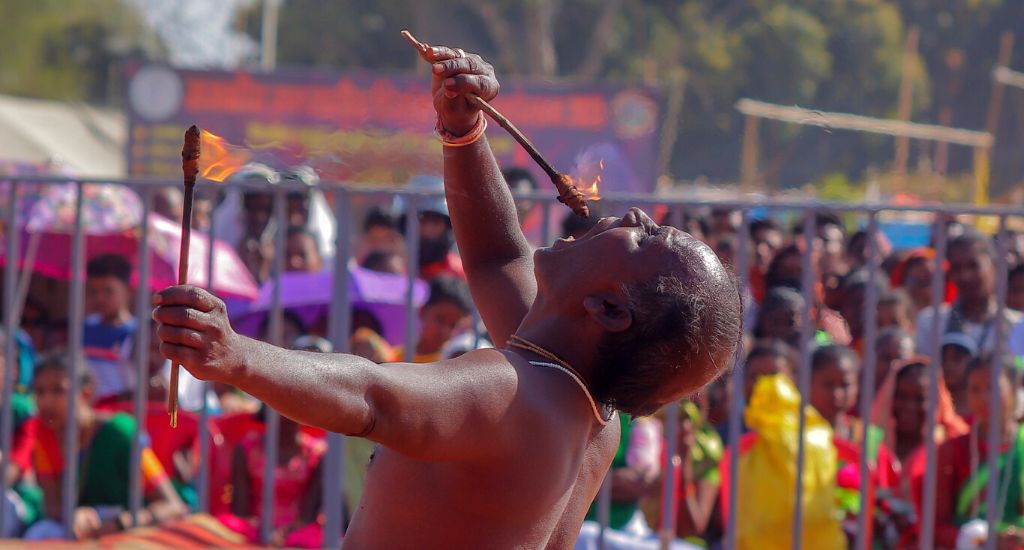
Tribal heritage and fashion at Hijla fair
The Hijla fair in Jharkhand’s Dumka district has been annually showcasing tribal talents and a lot more for over 130 years.

The Hijla fair in Jharkhand’s Dumka district has been annually showcasing tribal talents and a lot more for over 130 years.
Hands down Dumka’s most colourful annual celebration, the Hijla mela acts as a platform to showcase the art and culture of the tribal communities in Jharkhand.
The fair begins with traditional dance and music, and you can witness invigorating performances on traditional instruments like the mandar and tamak (drum), tirio (bamboo flute), junko (ankle bell and banam (fiddles).
In just seven days, anyone can understand the magnificence of the Santhal community because of this fair
Through the seven days of festivities, one is made privy to the many games played by tribal communities, like sekkor – a game involving an egg made of wood – played by the Ho tribals in Chaibasa area of Jharkhand. And kati – a game that involves quick reflexes, skillful footwork and a bamboo stick.
Many tribal artists from across the country participate in this fair by exhibiting their artwork.
Somewhere between the months of February and March lies Phalgun, the 12th month of the Hindu calendar. This is also the season when most of India’s farmers have finished their agricultural labour and are in a cheerful and festive mood.
The fair is held during the ‘shukla paksha’ (waxing moon fortnight) of the Phalgun month – usually between February-end and the first half of March – as this period is considered auspicious for celebrations, wherein the rich cultural history of the state is portrayed in all its splendour.

The Hijla fair, held on the Mayurakshi coast, about 4km from Dumka, highlights both – the distinctive cooperation between the tribal groups and their common history with the nearby non-tribal towns.
Also Read | Bhagoriya festival – Of blooming flowers and blossoming love
“This is not an ordinary fair. Hijla mela has been maintaining the tribal culture for centuries and is seen with a lot of respect. In just seven days, anyone can understand the magnificence of the Santhal community because of this fair,” Mukesh Tudu, the organiser of the event, said.
A rebellion by the Santhals – the largest tribe in Jharkhand and West Bengal – to end the revenue system of the British East India Company, also known as the Hul movement, led to the initiative that is now celebrated as the Hijla mela.
It is believed that the annual festival was started in 1890 by British Deputy Commissioner R Casteyers, with the aim to understand local tradition, customs and social regulations, and to establish direct communication with local people.

The government of Jharkhand declared the annual fair as a festival in 2008. It was in 2015, however, that the event was given the status of a ‘state fair’.
‘Hijla’ meaning ‘his’ is a commemoration of tribal people.
A fair that promotes diversity – Hijla provides a stage to intellectual debates, quizzes and lectures. College students recite folk tales, competitions are held between various cultural groups, and shows featuring national and international artistes are organised.
Various departments of the government set up booths at the fair to inform the public about the government programmes. Farmers are also educated about contemporary farming methods by officials of the agriculture, horticulture and fisheries departments.
Also Read | Sohrai: A tribal festival celebrating cattles and nature

From sports and book shops to cattle trade and stalls serving delectable tribal cuisine – there’s something for everyone, including pets, at Hijla.
The last day of the fair hosts the much-awaited fashion show, for which the models are selected from among the tribal youth, thus encouraging every generation of the tribal people to participate.
The lead image at the top shows a performer showcasing his skills at the fair (Photo by Munna Jonny Babu)
Reporting by Monika Marandi. She is an independent journalist based in Delhi. She is a Rural Media Fellow 2022 at Youth Hub, Village Square.